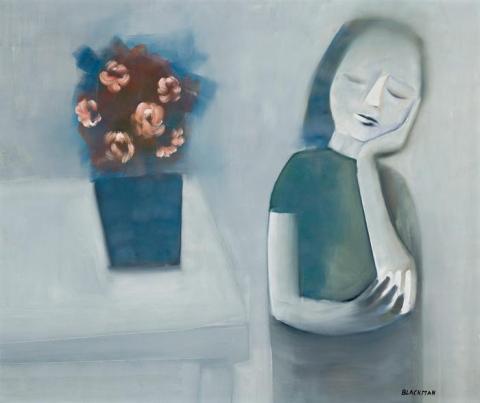ROOM AT TWILIGHT, c.1963
Charles Blackman
oil on composition board
126.0 x 150.0 cm
signed lower right: Blackman
Julian Sterling, Melbourne
Acquired from the above c1965
Private collection, Sydney
Much of Charles Blackman's imagery is drawn from the realms of dreams and childhood fantasies, occasionally touched by those passing moments of twilight, which inspire the poetic imagination. Lyrical as it at first may seem, his imagery explores depths of human experience, couching the realities of life and experience in poetic form. His paintings are invariably rich in metaphorical reference, as in Room at Twilight. The restful image of a young woman beside a pot of flowers is redolent with peace and beauty, enhanced by the twilight - an especially appealing time, when day slips gradually into night. The references to transience are twofold - day and beauty, as exemplified by the flowers, are subject to change, beauty like light passing and fading. This is taken up in the figure of the woman. Her eyes may be closed in rest; but we know that Blackman's wife was losing her sight, a world of impending darkness. These images as metaphors of approaching blindness, express a calm acceptance of the inevitable. Although touched with melancholy and the mood introspective, they are full of gentle beauty, like painted sonnets on beauty and blindness.
The image of young women and flowers is central to Blackman's art, the theme emerging in the late 1950s after his Alice in Wonderland series, which was a kind of harbinger. Some memorable examples include Reverie, 1958, and The Presentation, 1959. 'For Charles Blackman,' Nadine Amadio wrote, 'girls and flowers are an eloquent form for his personal poetry', adding that many of these paintings 'were reflections of his wife.'1 Their success was immediate, an early group winning him the Helena Rubinstein Travelling Art Scholarship. This introduced those fruitful years in London where Room at Twilight was painted. Commenting on Blackman's 1965 show at Zwemmer Galleries, T. B. Rosenthal of the London Listener perceptively observed, 'In these paintings Blackman has achieved that most rare of combinations, sheer sensual beauty and intellectual excitement.'2 Blackman has long been a master of the language of figures, especially in isolation, excelling in that paradox of the seeming simplicity of statement achieved by the sparest means to reach insights into the human condition denied a lesser artist. Of his 1964 show at Melbourne's South Yarra Gallery, Alan McCulloch wrote, 'The ultimate in plastic lyricism is Blackman's holy grail, and in three major paintings (Twilight in the Room, Remembrance, Face to Face) the elusive vessel comes within touching distance.'3
1. Amadio, N., Charles Blackman: The Lost Domains, Alpine Fine Arts Collection, Ltd, New York, p. 44
2. Listener, London, 30 September 1965, quoted in Shapcott, T, Focus on Charles Blackman, University of Queensland Press, Brisbane, 1967, p. 71
3. Herald, Melbourne, 18 March 1964, quoted in Shapcott, op. cit, p. 68
DAVID THOMAS
